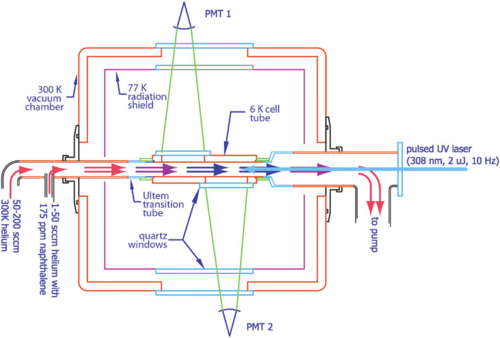Mixture Analysis
About The Mixture Analysis Experiment
The cooling of large molecules and biomolecules is a relatively unexplored area of cold molecular physics. It was recently demonstrated that napthalene, a two ring hydrocarbon, can be effectively cooled via buffer gas cooling. The upper bound on the size and complexity of molecules which can be effectively cooled by buffer gas cooling is unknown. We are exploring techniques for cooling these large molecules as well as collisional physics of large molecules in the gas phase.
A powerful application of buffer gas cooling of large molecules is in precision spectroscopy. Absorption spectra of large molecules are broad and unpredictable. When large molecules are vibrationally and rotationally cooled, their absorption spectra become very sharp. Recent experiments have demonstrated that electronic structure and corresponding vibrational manifolds can be readily resolved at cryogenic temperatures. Furthermore, arbitrary mixtures of large molecules can be effectively cooled via buffer gas cooling. Current research is focused on spectroscopically identifying constitutions of a complex mixture. Currently, a tunable OPO laser is used to identify features across an arbitrary region of the spectrum. Future research will focus on microwave spectroscopy, which may yield higher signal-to-noise ratios and the possibility of fast Fourier Transform Spectroscopy.
The Set Up
People
- Garrett Drayna
- Dave Patterson
- Edem Tsikata (Now a postdoc at JPL)
Publications
- Cooling and Collisions of Large Gas Phase Molecules. D. Patterson, E. Tsikita, and J.M. Doyle. Phys Chem Chem Phys. 12(33), 9736-41 (2010)
